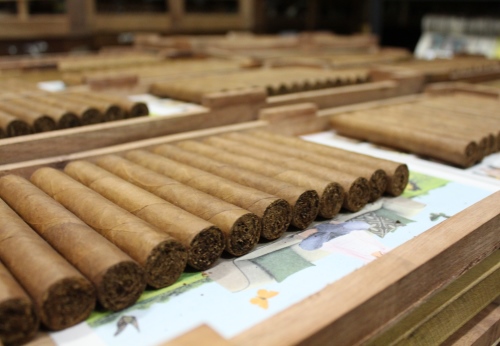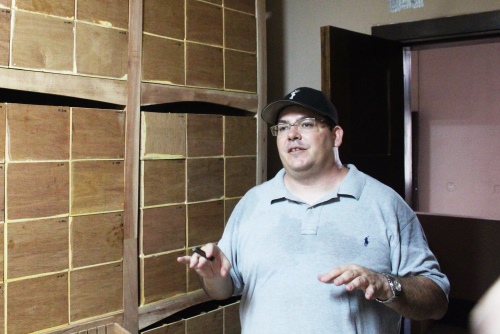Commentary: What is Meant by ‘Cigar Blending’?
7 May 2014
I’ve had the privilege to blend three different cigars in the past few years, all thanks to my participation in Drew Estate’s Cigar Safari. In each case I chose a different wrapper. I chronicled the results of my Connecticut Ecuador and Brazilian Mata Fina blends here, and I anticipate writing about my latest, Cameroon-wrapped attempt shortly. (Spoiler alert: The Cameroon smoke is quite good, if I do say so myself.)
Each time I’ve blended a cigar, the process has been similar. I’m presented with a menu of pre-selected, pre-fermented, aged tobaccos. They are organized by filler, binder, and wrapper. Based on the vitola format of my choosing, I’m told how many filler leaves I’ll need. And while barber poles and double-binders are certainly on the market these days, I’m instructed to select just one wrapper and one binder.

Besides a few general rules of thumb (don’t overstuff with Ligero to avoid intensity and burn problems, pick a combination of sweet and spicy tobaccos, etc.), every time I’m stabbing in the dark. For me, the process is all trial and error. I’ll walk around the tobaccos, select some filler leaves, crudely stuff them in a binder, get some wrapper in there, and light the whole bunch on fire to get a sense of the general profile. Extinguish. Re-blend. Repeat.
Usually about 60 minutes is allotted for this exercise. I’d love to have a whole day to do this. Maybe a whole week. But even then it wouldn’t be nearly enough time. When the hour comes to an end, I jot my recipe down and hand it in. Several days later I receive about ten cigars. Thankfully, the folks at Drew Estate don’t make us roll the smokes ourselves; my creations would be unsmokably poor-constructed.
Even if my result doesn’t taste positively top-notch, smoking a cigar you’ve blended is thrilling. I keep my ego in check, though. Remember that Drew Estate had already done all the hard work before I made any decisions. They sourced and selected the tobacco. They cared for it, fermented it, and aged it. And they gave me paragraphs of info on each type of tobacco so even a novice like me can yield something decent.
Going through this exercise several times got me thinking: What exactly is meant by cigar blending? What does someone like Willy Herrera do when he’s hired at Drew Estate before the Herrera Estelà line is launched? What did José Blanco do when he was crafting CyB?
Despite the photos in advertisements and the pictures on boxes, surely the great cigar men are not wandering sun-drenched tobacco fields all day with fedoras and white, button-up shirts with breast pockets brimming with cigars. These strike me as mere photo-ops. What really happens when the rubber meets the road in blending?
I’d imagine the answer varies by company and by individual. But folks I’d consider cigar blenders seem to be engaged at various levels of the process—from seed to smoke, if you will. And their activities (meeting with suppliers, checking tobacco that’s fermenting, producing test blends in various sizes, providing instruction to the buncheros and rolleros, etc.) are differentiated from the business aspects of cigar making (payroll, strategic direction of the company, marketing, budgets, etc.).

Perhaps the best understanding of cigar blending was shared with me by Skip Martin when I visited his RoMa Craft operation in EstelÃ. At the back of his small factory, he had a table full of cigars that were made 100% with one type of tobacco. Martin says he’s constantly smoking these sticks—some of which are not completely enjoyable on their own, mind you—so he instantly knows what the various tobaccos taste like on their own. He stores these mental snapshots so, as he’s creating test blends and finding areas for improvement, he knows exactly which tobaccos to add and which to remove.
In this fashion, true cigar blenders know what the tobaccos they work with taste like—just like you and I know what peanut butter tastes like without having eaten peanut butter recently. This is what it takes to be a cigar blender. Everyone else, myself included, is simply engaging in trial and error. We lack the skills to add the level of targeted refinement that’s required to yield an excellent cigar.
This realization only adds to my enjoyment of a balanced, harmonious smoke. I hope it does so for you as well.
photo credit: Stogie Guys

 Patrick Ashby
Co-Founder & Editor in Chief
Patrick Ashby
Co-Founder & Editor in Chief Patrick Semmens
Co-Founder & Publisher
Patrick Semmens
Co-Founder & Publisher George Edmonson
Tampa Bureau Chief
George Edmonson
Tampa Bureau Chief
Great commentary. I've thought about this, and just kind of figured it's a ton of trial and error based on the tobacco that's available. Skip's strategy for refinement makes sense. And whatever he says has to resonate, because RoMa is making some of the best cigars in the world right now. Period.
Agree. Love RoMa Craft… Heavy